Future Hangs in the Balance as Retail Industry Passes Tipping Points
By Jim Tompkins, CEO
June 2012
www.tompkinsinc.com
The retail industry has reached its biggest crossroads in history.
Near the dangerous intersection of business as usual and success going forward sits retail strategy, an explosion of online sales, technology, omnichannel, multichannel, and social media. The customer is now in the driver’s seat, and Amazon is leading the pack by a wide margin whether all retailers realize it or not.
Business questions that were once heavily debated no longer matter as much at this crossroads. These questions include where to locate stores, distribution centers (DCs), and fulfillment centers, and how to minimize the cost of the distribution network. These are structure considerations that revolve around the all-encompassing business strategy, and at these crossroads we must address strategy before structure.
The traditional thinking around distribution networks and distribution operations is obsolete, given the current retail crossroads.
With social media, technology and customer sophistication booming, retail finds itself at a critical crossroads. Between now and holiday season 2013, major decisions will be reached by both in-store and online retailers that will result in a flood of retailer bankruptcies not seen since the dotcom bubble burst of 2000.
This paper provides the first complete view of Retail at a Crossroads and explains how companies can flourish in this quickly evolving environment. Multichannel Operations Excellence (MOE), teamed with a keen understanding of the Four Pillars of Success explained here, will bring clarity to this crossroads.
‘PERFECT STORM’ FOR RETAIL TRANSFORMATION
There are two ways to view the current retail crossroads.
-
A long-term perspective: The retail industry undergoes a major transformation every 50 years. About 150 years ago, big cities made the modern department store possible. Then 100 years ago, the automobile made malls viable; 50 years ago, the evolution of the discount stores changed retail. This progression then opened the door to the specialty big box stores. The most recent transformation involves online retail.
-
A short-term perspective: One or two retailers influence the entire industry every decade within the context of the long-standing 50-year transformations. In the 1980s with the dawn of the Walmart decade, the giant big box retailer prospered, because they leveraged the power of supply chains. The 1990s was the decade of Gap, with its reinvention of the specialty retail store. And then boom – the retail industry after year 2000 is feeling the major impact of both Amazon and the Apple Store.

Between now and holiday season 2013, major decisions will be reached by both in – store and online retailers that will result in a flood of retailer bankruptcies.
Business strategy, customer expectations, and technology have now converged to create the perfect storm as a result of both the 50-year and the 10-year transformations. This is bigger than the dotcom bubble; this is definitely bigger than it appears in the rearview mirror.
SIGNS POINT TO RETAIL CROSSROADS
Customer expectations are leading the way in this critical retail crossroads.
Through social media, increased customization, and same-day or next-day delivery, customers are signaling that companies’ successes and failures rest on their continuing high expectations of price, selection, convenience and experience. From business news, at the time of this writing, a clear pattern foretelling the retail crossroads has emerged. Consider these reports from such diverse sources as The Wall Street Journal, Harvard Business Review, Fortune, and retail and consumer products publications:
-
The era of big box retail dominance is coming to an end.
-
By 2015, online business is expected to be worth $1.4 trillion worldwide, $280 billion of which will come from the US.
-
Online sales in the US currently represent 9% of total retail sales (up 5% from five years ago). The online sales ratio is 10% in the UK, 3% in Asia- Pacific and 2% in Latin America.
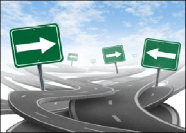
As Europe struggled with the recent financial crisis, online retail sales grew 18.2% in 2011 even as total retail sales were flat. Amazon in Europe grew 37.2% in 2011.
-
China’s online retail sales are on track to triple to $360 billion by 2015, making it the largest global online retail sales market.
-
Sixty percent of consumer goods manufacturers are selling direct to customers, and one of the fastest growing segments of web commerce is the manufacturing direct-to-consumer segment.
-
Best Buy, Sears and Lowe’s aren’t just closing stores for the sake of appearing to care about every penny to the bottom line. These organizations are in real trouble. At the same time, with in-store sales flat, Lowe’s online sales grew 70% in 2011.
-
This approach does not work anymore: “Here’s some product and here’s some advertising, hope you like it!”
-
More in-store retailers are coming to the realization that they do not need to expand their store count or operate as many locations because more of their business is online.
-
Most major retailers still don’t get that just opening their doors is not enough anymore.
-
Malls are seeing less and less traffic.
-
In 2011, Amazon experienced 41% revenue growth, while Walmart realized just 8% growth (less than 2% of Walmart revenue was online). Walmart has awakened and now has plans to take on Amazon.
-
The number of people who turned to social media as a source to learn about new products more than doubled in less than a year – from 24% in 2010 to 49% in 2011.
-
In 2011, Nordstrom’s online sales rose by 30%; Macy’s were up 40%.
-
Traditional retailers must transform the one big feature that online retailers lack (stores) from a liability into an asset. For example, by holiday 2012, Macy’s will have 300 stores capable of handling fulfillment of online orders.
-
Amazon’s decision to go after high fashion is about economics. Amazon’s costs are about the same whether it is shipping a $10 book or a $1,000 skirt – gross profit per unit will be much higher on the fashion item.
SEVEN TIPPING POINTS
It is not really one tipping point that has put us at this crucial crossroads, but seven.
How retail companies respond to these tipping points will determine their future.

In 2011, Amazon experienced 41% revenue growth, while Walmart realized just 8% growth (less than 2% of Walmart revenue was online).
-
AMAZON
Amazon is the standard for retail excellence, not only for online, but for all of retail, because it is the model for being customer- centric. Amazon has created a new way to connect customers with solutions. By providing content about product features, a community of opinions about the product, and finally the commerce (price and availability) of the product, it really understands how to grow both the top line and bottom line. This makes them everyone’s competition. Amazon is excellent on price, selection, convenience and experience. It is no wonder that retailers across all categories have begun studying Amazon in an effort to uncover their “secret sauce.”
All retailers need to fear Amazon. And with the birth of AmazonSupply in late April of 2012, it has expanded into new business markets for industrial, scientific and commercial items. There is every reason to think that the giant e-retailer will continue to expand its customer base and attractive delivery options.
-
ONLINE SUCCESS
In-store retailers are realizing substantial growth from online business. As companies reach the 7-10% level of total revenue originating from online sales, they are taking note and beginning to consider what happens if this becomes 15-20% of total revenue.
In-store retailers are searching for answers and trying to understand multichannel, omnichannel, social networks, technology, global offerings and the “endless aisle.” Showcasing products online and at self- service kiosks gives retailers an endless aisle to offer a wide range of SKUs and models that they could not afford to stock in their stores. At the same time, retailers are not only at war with Amazon and other retailers, but also with manufacturers who are spreading their wings and going direct to online customers.

The youth culture “always – on” wireless connectivity psyche is at their core and increasingly drives online growth.
-
TECHNOLOGY
The smartphone, the tablet, and web technology are all enhancing the experience of online shopping. More than 10% of all online transactions are now completed on a mobile phone. Barcode scanning and mobile coupons are emerging as a top activity on smartphones, along with store finder and in- store stock checks. Flash sales and geofencing are all the rage for bargain hunters. Customers today crave frictionless shopping, and this typically means using technology.
-
SOCIAL COMMERCE
The salesperson who asks the customer, “May I help you?” has become irrelevant to some shoppers. “I don’t even know you, how could you possibly help me?” the modern customer is likely thinking. Due to social networking, he or she is not actually shopping “alone.” She is backed up by a whole team of trusted people who know her tastes and habits. The digital realm has taken the process of word-of-mouth communication to a whole new level, often 140 characters at a time with Twitter.
Today, 68% of all people trust other people “like themselves” – this is up from 22% in 2003. Shopping has always been social, but the era of online shopping and low paid, unmotivated store staff took the social out of retail. Now, social commerce is exploding and both online and in-store retailers are learning to embrace it. As customers become better oriented to using social media and smartphones, so too must retailers, before their customers are no longer their customers.
-
YOUTH CULTURE
Younger customers are leading a shift to online, and as they grow older, they are buying more. The youth culture “always-on” wireless connectivity psyche is at their core and increasingly drives online growth. Greater comfort with both technology and social networks is bringing about major changes in customer acceptance and even preference for online shopping.
Consider that 98% of all 18-24 year-olds have a social network account and they spend almost twice as much time online as they do watching TV. The average 18-24 year-old sends 1,300 texts per month; and, the average 13-17 year-old sends more than double that amount.
-
POOR AND IMPERSONAL IN-STORE CUSTOMER SERVICE
The quality of store staff, service, and training are all lacking and have significantly degraded the experience of shopping at stores. Many customers will pay more and be inconvenienced just to avoid the poor and impersonal customer service of some of today’s big boxes. Surveys have recently indicated that a good number of in- store retailers act as if the customers have come into their stores to fill their needs; this is definitely not true anymore. The customer is in charge.
-
STORE RELEVANCE
Retail stores must again become an escape, an adventure, an experience, a unique place to touch and feel, to interact with others, to have a “feel good” experience and to enjoy shopping. It is an opportunity for physical store locations to become relevant again.
Stores have the unique advantage of offering “try before you buy,” so this asset can be leveraged to make shopping in a store more relevant to customers.
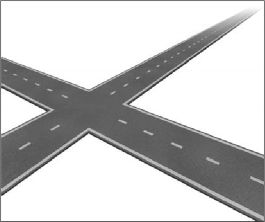
HOW DID WE GET HERE?
Online retailing launched in 1995 when Amazon and eBay began filling customer requirements via the Internet.
In the 1990s, online retail was focused mainly on books and computers but now has evolved to an endless list of products and is growing rapidly. Online retail will continue to take away sales from stores. By 2015, online retail in the most progressive markets will only hit 20% of the total retail spending. In 2025, online sales will still be only 25% of all sales globally.
Therefore, although online sales are expected to be the prominent retail growth area, physical stores are still very, very important. At the core of Retail at a Crossroads is the dilemma of maintaining balance and achieving synergy amongst online, in-store and omnichannel.
It is clear Amazon is flourishing, with a five-year average ROI of 17% versus 6.5% ROI for discount and department stores.
Even more important, however, than ROI is the Return on Invested Capital (ROIC) since online holds an unapproachable advantage over in-store on ROIC. It is also clear that the Apple Store is doing well at $6,000 of sales/square foot versus $194 of sales/square foot for Kohl’s and $171 of sales/square foot at Macy’s. Amazon and the Apple Store are the huge winners of the last decade.
As retail continues to respond to the customer and evolves going forward, the industry will pass the 2012 model as surely as the last decade saw the following retailers pass through bankruptcy:
-
2000 – Boo.com, etoys.com, Garden.com, Kozmo.com, Pets.com
-
2001 – Montgomery Ward
-
2002 – Ames Department Store
-
2003 – Spiegel
-
2004 – Bess Eaton
-
2005 – Musicland
-
2006 – European Home Retail
-
2007 – Bombay Company
-
2008 – Linens n’ Things
-
2009 – Crabtree & Evelyn
-
2010 – Blockbuster
-
2011 – Borders

The expectation today is that on orders over
$25, shipping will be free on “normal” delivery time frames. By holiday 2013, the expectation is that all shipping will be free.
FOUR PILLARS OF RETAIL SUCCESS
What do customers really want?
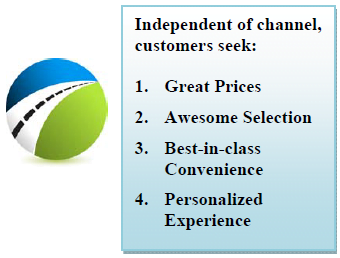
A great deal of time and money has been spent on this very question, but it really boils down to these four pillars – a required stop on the road to retail success.
Great Prices
Today’s customers expect good value for the money and have a strong awareness of the total price (item price + shipping cost + sales tax) of the items they want to buy. The customer’s ability to have total price transparency presents a clear expectation for price competitiveness.
The expectation today is that on orders over $25, shipping will be free on “normal” delivery time frames. By holiday 2013, the expectation is that all shipping will be free.
On the topic of taxes, Amazon has significant advantages here as they currently only pay sales tax in five states (this will move to six states by July 2012; seven states by September 2012; eight states by September 2013; 11 states by January 2014, and 12 states by January 2016; with other states still being negotiated). Regardless, Amazon’s scale provides for lower shipping costs, lower acquisition costs and higher inventory turns.
Awesome Selection
Today’s customers want what they want. Modern customers become weary if they must wait for the sales clerk to find an item in the back room. Customers want a broad assortment and expect their item to be available. They may desire customization and are surprised if it is not available.
Customers desire help in finding related items (“What shoes would look good with this dress?”) and in receiving recommendations (“Here are some ties that look great with your new suit”). Examples of great selection include Walmart.com, which has almost six times as many SKUs online as they do in-store. Also, Amazon has more than 200,000 shoe SKUs available and close to 3,000 denim SKUs.
Retailers beyond the crossroads pass through “virtual retail,” “non-stock retail” or “endless aisle retail” to offer all SKUs in which customers may have an interest in purchasing. Therefore, limiting selection is not a strategy that will work in the future. Unlimited selection will become the norm very soon.
Best-in-class Convenience
Today’s customers, in addition to being concerned about price and selection, are worried about their time. They want shopping to be quick and easy, or they want it to be entertaining.

A major transformation will propel retail to a whole new place – one that allows immediate response to customer expectations.
Online customers seek same-day or next- day delivery, but for now will accept three- to four-day delivery. Going forward, same-day or next-day delivery will be the norm for most items sold online. Consider that today in China, the delivery is not measured in same-day or next-day terms, but in hours. The goal for delivery in major cities in China is four to six hours.
Customers also want returns to be quick, easy and hassle free. They prefer online returns to be free. By holiday 2013, they will demand that online returns be free. Customers want shopping to be done on their terms and when, where and how they want to do it. They expect to easily obtain feedback and responses to their questions and interact freely via their mobile devices.
Customers expect clear, transparent communications that enable them to make informed choices. Amazon has developed many innovations in regard to online convenience, including one-click check-out and advanced search and recommendation functionality, as well as Amazon Prime.
Similarly, Walmart recently determined that a segment of their customers do not have credit cards and are precluded from shopping online. To solve this issue, Walmart now has a “Pay with cash” button on its website so that customers can order online and choose the store where they can go to pay for their orders with cash.
Personalized Experience
Today’s customers demand that retail channels work in unison. They want the same stellar level of treatment in-store and online. This may take the form of an intimate, personal dialogue, or an engagement as per customers’ specifications. It may be in person or via a social element (Customers who bought this also bought…Customers who viewed this also viewed…Frequently bought together… customer reviews, etc).
They expect order accuracy, reliable descriptions and zero surprises. As Zappos says: “Customers want retailers to deliver ‘WOW’ through service,” whatever the customer’s definition of service may be. Zappos defines ‘WOW’ on service as “Free shipping, free returns, free 365-day return policy, 24/7 customer service and happiness.” So, for this successful online retailer, it is beyond convenience – the shopping experience must bring happiness. They strive to make the shopping experience fun, exciting, entertaining, emotionally engaging, efficient and educating.
Here are a couple of examples of how retailers are enhancing the shopping experience. At Sephora’s cosmetics stores, customers are lent an Apple iPad to make their in-store shopping experience more enjoyable. The mind behind the Apple Stores, Ron Johnson, is now revamping the JC Penney in-store shopping experience by redesigning the stores to be mall-like by having 100 mini-boutiques arrayed around a fun and engaging “town square.”
Increasingly, customers are saying, “Remember me when I want to be remembered; contact me when and how I want to be contacted; reward me for my loyalty when and how I want to be rewarded; and positively surprise me when and how I want to be surprised never negatively surprise me.”
Customers are also allowing information gathering at each point of contact and want retailers to use this information to enhance their shopping experience.
THE FUTURE IS IN ‘MOE’: MULTICHANNEL OPERATIONS EXCELLENCE
As retail continues to evolve, it is clear that neither the Amazon 2011 model nor the Apple Store 2011 model will be where retail is headed in the near future.
Instead, a major transformation will propel retail to a whole new place – one that allows immediate response to customer expectations and rapid adoption of new innovations in the marketplace.
Some have taken hold of the word “omnichannel” to represent the correct path leading from Retail at a Crossroads. But, since omnichannel is a relatively new word, move forward with caution. The thinking behind omnichannel is that retailers need to interact with customers in an integrated, consistent way (think channel continuity, or sometimes termed “enterprise selling”) via many channels (websites, stores, catalogs, kiosks, direct mail, social media, mobile devices, television, etc.) that provide customers with endless value and satisfaction.
The real challenge of the current crossroads, however, looms larger. Succeeding at omnichannel is a real positive for retailers, but unto itself, it is inadequate. Eliminating the internal barriers created between different channels is beneficial, but it is not the answer that customers are seeking.
To move beyond the crossroads, retailers need to provide excellence within several channels as well as the omnichannel. Engaging and serving customers under their own terms (how, when and where) compels retailers to achieve MOE.
MOE demands that every aspect of retail be entertaining, interactive, educational, exciting, fun, engaging and personalized. Retailers who employ MOE will set the pace for the next decade as well as define retail excellence for the next 50 years. But approaching MOE requires a major transformation.
This is not saying that pure online and pure in-store will fail. To the contrary, these models can be made to work if retailers are involved in multichannel in all cases. So, a pure online retailer should use multiple online channels such as Amazon, Google, and Yahoo, and a pure in-store retailer should use Facebook, Groupon, Pinterest, and similar.
In this age of connectivity, mobility, and social networking, retailers will need to focus on adapting to how their customers make decisions and purchases. Thus, multichannel access may involve in-store promotions by reaching out to customers in new ways; or integrating online and physical stores operations to leverage the access with customers (online order with store pick-up, or returns, and store selection with home delivery); or partnering with online competitors to broaden the brand appeal to a wider audience; or integrating online and/or in-store promotions with social media such as Twitter and Facebook.
Regardless, achieving MOE requires the adoption of new processes and technologies so that effective selling techniques will continually delight customers.
WHAT MOE IS AND IS NOT
Realizing that customers want everything and they want it their way goes to the heart and soul of Multichannel Operations Excellence.
The transformation to MOE begins with an understanding that today’s customers are beyond:
-
Having an “interface” with the retailer, and instead desire an engagement (on their terms) with the retailer.
-
Listening to the retailer, and instead seek a dialogue with the retailer.
-
Understanding the retailer’s value proposition for customers, but want to understand their own value proposition.
-
Needing rules and barriers to customer service, but instead want a true customer-centric view of service, performance and delight.
-
Accepting retailers who do not get the social issues related to poor sustainability, child labor laws, and other key areas.
-
Accepting bad shopping experiences and poor, impersonal service.
-
Seeking a single channel experience. Different channels for different product categories are in demand. The customer will decide that for some products they want only an online interaction, but for others, they want “try before you buy” satisfaction.
-
Accepting bad surprises from their shopping. Extra fees, negative experiences, and having retailers tell them how they should shop are all unacceptable.
-
Accepting yesterday’s shopping experience, but also want and expect to be constantly impressed with innovations and given services they did not even know they wanted.
TRANSFORMATIONAL PATH FORWARD
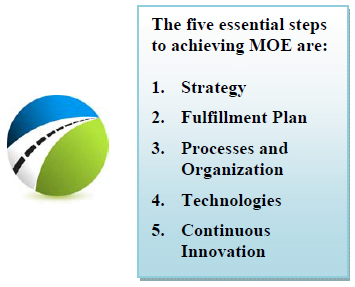
Once company leaders recognize that MOE is the right direction, how do they begin moving beyond the crossroads? By pursuing the right retail strategy, the right technology, and the right supply chain structure. It is always strategy before structure.
Strategy
The first step in reaching any new position of performance is to develop the right strategy for the specific business. There is no substitute, or shortcut. The “blind spot” where many retailers fail is in not defining their strategy well, or not being able to communicate it to all stakeholders – investors, management, employees and customers. Basically, strategy has three components with key questions that must be answered before moving forward:
-
Target Market – Who are our targeted customers? How are they segmented? What do they need and expect?
-
Products, Services and Value Proposition – What do we provide, and why should our target customers buy these from us? How do we distinguish our value proposition? How do we know how well we are doing?
-
The Capabilities – What do we need to deliver? How should we do it, and is there a compelling theme that differentiates us? What are our critical success factors?
A few examples of obsolete strategies that will not work at today’s crossroads include:
-
In-store and online retail channels that are treated as separate businesses.
-
Pure in-store retailers who do not offer a totally unique shopping experience.
-
Pure online retailers who do not provide same-day service or endless aisle selection.
-
In-store and online retailers who do not provide same-day service or endless aisle selection.
-
In-store, online or combination in-store and online retailers who are not selling globally.

It is always strategy before structure.
Fulfillment Plan
Once the strategy is clear, proceed to infrastructure – planning the network of fulfillment centers, DCs, direct delivery centers, forward fulfillment centers, direct special services centers, depots, forward picking locations, cross-docks and other processing/shipping locations.
This network is no longer a straightforward, computer-based exercise of minimizing total costs. A huge challenge that must be met with gusto is how this network contributes to the best-in-class convenience described under the “Four Pillars of Retail Success.”
In addition, decisions must be made with respect to doing fulfillment internally or outsourcing to logistics service providers. The fulfillment plan will include the preliminary facility plan, transportation plan, inventory deployment plan, customer interfaces and endless aisle partners.
To complicate matters even more, companies have to consider tax rates, real estate costs, energy costs, and incentives, as well as labor availability, cost and flexibility.
Processes and Organization
To move retailers beyond the crossroads, major process and organizational transformations are required. The forward- thinking processes and organizational requirements that will be critical success factors for future retailers include:
-
Market Intelligence
-
Customer Centric
-
Global Player
-
Product Presentation
-
Endless Aisle
-
Demand-driven
-
Supply Chain Execution
-
Technology
-
Flexibility
Advancing beyond the crossroads means that retailers will need to re-engineer their Key Performance Indicators (KPIs) and approach to compensation, along with intensifying their focus on customer-centric service and growing globally.
At the same time, retailers must address the transformational changes of endless aisle and become more demand-driven in their supply chains.
The very nature of MOE and its potential to drive change compels companies to pay attention to the processes and the organization.
Technology
The new MOE processes will necessitate new enabling technology. The traditional practices of planning, sourcing, allocating, deploying, merchandising, moving, storing, fulfilling, delivering, selling and last mile will not work effectively for MOE.
The focus today is on demand shaping, markdown optimization, promotion management, outlet management, flash sale management, non-stock inventory management, store versus only online inventory management, demand-driven supply chains, distributed order management, online fulfillment, and inventory planning and allocations.
All of these applications can be bolted onto most existing retail ERP systems, so it will not be a four- to six-year implementation cycle. In fact, many of the technology solutions going forward can be done on a cloud and integrated on top of an existing ERP.
But, do not try to achieve MOE without a clear and strong understanding of the new technology needed to achieve MOE.
Continuous Innovation
The final step recognizes that even the best strategies, fulfillment plans, processes and organization, and technologies will not be cost-effective or customer-endearing forever. The world of retail has changed rapidly. This will not only continue, but it will keep accelerating.
Retailing is all about adapting to change. Customer expectations are expanding every day, and if the retailer cannot keep up, the shopper will follow the path of least resistance or the path that is most convenient and pleasing.
Customers have alternatives for not only products, but also where they shop, when they shop and the ways that they research, browse, compare, order, pay for, receive, unpack, use, support and/or return the products they desire.
Thus, the path beyond today’s crossroads must include how changes can be accepted and embraced with the fewest cost and time delays.
This evolution will require that strategies, fulfillment plans, processes and organization, and technologies be designed with changes in mind – not actually knowing what they will be in the future.
While anyone can speculate about speed, velocity and flexibility, the customer vision of “anything, anytime, and any way I choose” will lead every retailer to embrace change and prepare for it in order to survive.

The world of retail has changed rapidly. This will not only continue, but it will keep accelerating.
MOVE BEYOND THE CROSSROADS
Retail stores are certainly not going to disappear any time soon.

There are only 3% fewer stores in 2012 in the US as compared to 2011.
In addition, more than half of retail growth across all categories will result from in-store purchases. Therefore, stores will continue to be where the majority of retail sales occur in the foreseeable future.
The physical presence of retail stores is not the point, however. In a multichannel retail world, it is not important from which channel satisfied customers are obtained. The goal is to gain enough satisfied customers in all channels to survive and prosper.
Understand that Amazon will soon be in all markets and that they are a strong competitor. What compelling case of price- selection-convenience-experience can companies make to convince enough customers to continue to do business with them? And the overarching question: Who is willing to embrace MOE and make the tough choices needed to move beyond the crossroads to be successful?
There is no doubt that retailers live in exciting times. But these are not easy times. To further help unravel the opportunities and solutions of Retail at a Crossroads, see the graphic presented on the next page. This picture reveals the nature of the crossroads and the path to achieving retail success.
The tipping points are already starting to slant toward the crossroads, and success lies in understanding and following MOE and the Pillars of Success.
In the retail industry, it has traditionally been said that the “customer is king (or queen).” With online sales, social media, and multichannel fulfillment peaking, this statement has never been truer. It is time to meet at the crossroads and move forward.
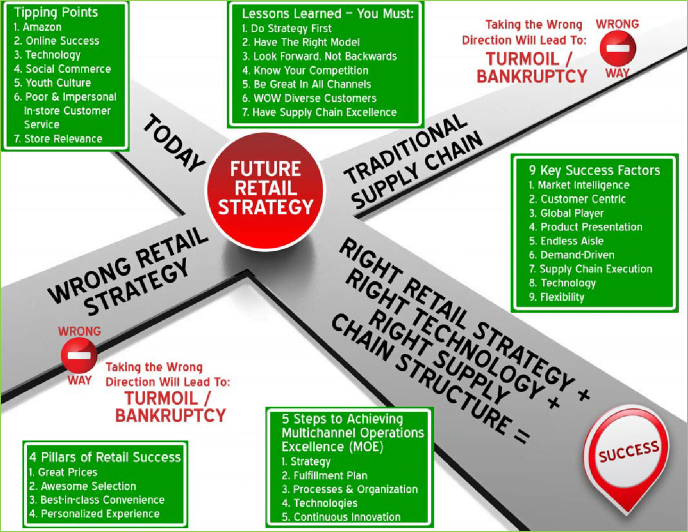
About Tompkins International
Tompkins International transforms supply chains to help create value for all organizations. For more than 35 years, Tompkins has provided endtoend solutions on a global scale, helping clients align business and supply chain strategies through operations planning, design and implementation. The company delivers leadingedge business and supply chain solutions by optimizing the Mega Processes of PLANBUYMAKEMOVESTORESELL. Tompkins supports clients in achieving profitable growth in all areas of global supply chain and market growth strategy, organization, operations, process improvement, technology implementation, material handling integration, and benchmarking and best practices. Headquartered in Raleigh, NC, USA, Tompkins has offices throughout North America and in Europe and Asia. For more information, visit www.tompkinsinc.com.
This paper is the result of Tompkins International’s research of public information. There is no information presented that comes from any proprietary source. Tompkins International does not discuss information about their clients unless that information has been published.


